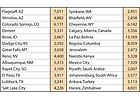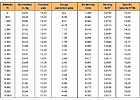
The effect of altitude on the performance of HVAC systems and components all comes down to the variable of atmospheric pressure. Below 10,000 ft, this effect is negligible on certain properties of air such as specific heat, thermal conductivity, and viscosity. However, important properties of air, such as density, enthalpy, and dewpoint temperature, are all affected to an extent that influences the way we must engineer our HVAC systems.
Many equipment manufacturers employ applications engineers who are adept at handling the issues encountered with making their systems perform at altitude. Their tasks include designing appropriate equipment features and options as well as answering questions from installing contractors and consulting engineers.
Consulting engineers who are located in mountainous regions have been designing around the challenges that high altitudes have presented for years. To them, this topic is second nature.
However, globalization and consolidation in the HVAC industry have increasingly exposed more engineers and manufacturers to these types of issues. These changes have required these individuals and organizations to spend time and effort on research and education. For instance, the Columbus, OH office of URS sits at about 800 ft above sea level, but we have had to educate ourselves in recent years in order to design several facilities in Colorado, and our Washington, DC office is involved with the design of 30 U.S. embassies across the world.
Altitudes vary widely, with even smaller countries such as Saudi Arabia having extremes from sea level to over 6,800 ft. Regions of China exceed 11,000 ft and areas of Bulgaria approach 10,000 ft. At one time, only populated areas were of a concern to the HVAC industry, but with the proliferation of wireless communications, air conditioning for remote site applications must also be considered. Table 1 shows elevations of selected cities, some of which may be surprising.

TABLE 1. Elevations of selected cities (in ft above sea level).
Air Density
Standard atmospheric pressure at sea level is 14.70 psi and is the cumulative result of all the air stacked above. As we climb in altitude, there is less atmosphere located above to impose its weight, and consequently there is less atmospheric pressure. The ideal gas law shows that for a given temperature, as the pressure on the air decreases, its density decreases as well. Table 2 lists atmospheric pressure in several ways, with air density expressions for various altitudes.We already know that at higher altitudes air is less dense, but what impact does this have on HVAC systems? Perhaps the largest impact is on fan performance, as their ratings are given at standard air conditions of 70°F and 14.696 psi. Fans are constant-volume devices, so as the air density decreases with increasing altitude, the mass flow rate through the fan decreases proportionately.
For example, a fan rated for 20,000 cfm will move 90,000 pounds of air per hour at standard conditions, but only 72,000 pounds per hour at 6,000 ft. Additionally, the fan laws show that a given fan operating at constant speed will draw less power and develop less pressure at altitude in direct proportion to the ratio of air densities. Fan manufacturers offer software to predict operating characteristics of their equipment at non-standard conditions.

TABLE 2. Atmospheric and air densities at altitude.
Altitude can also affect pumping systems by reducing the net positive suction head available (NPSHA) to a pump located in a loop open to the atmosphere. As the absolute pressure at the pump suction nozzle approaches the vapor pressure of the liquid, bubbles will form and collapse on the impeller, causing cavitation which can eventually destroy the impeller.
Each pump has a net positive suction head required (NPSHR) that varies with flow and impeller speed. For a pump to work properly, the NPSHA must always exceed the NPSHR. The classic example is a condenser water system that relies on atmospheric pressure and the elevation of the cooling tower above the pump inlet to maintain the proper suction pressure. A system layout that works at sea level may not work at 5,500 ft elevation since the atmospheric pressure is 2.7 psi lower, which is equivalent to about 6 ft of water.
Not only are fans and pumps affected by altitude, but the motors that drive them are as well. As air density decreases, its ability to cool the motor decreases and can lead to overheating. According to NEMA, altitudes in excess of 3,300 ft may require higher grades of insulation, elimination of the service factor, de-rating, or use of a larger motor.
Lower atmospheric pressures encountered at higher altitudes can alter the way we use charts that list the properties of compressible substances such steam, natural gas, and refrigerants. This is because the low side of a pressure gauge reads atmospheric pressure as a reference. For instance a saturated steam line reading 30 psig at sea level would have a temperature of 274°, but only 271° at 4,000 ft as the gauge correction factor as shown in Table 2 is -2.0 psia.
Psychrometrics
The psychrometric properties of air are altered at altitude above sea level. Consequently, ASHRAE has created charts for elevations of both 5,000 ft (Chart 4) and 7,500 ft (Chart 5), and the Carrier Corporation has a chart for 10,000 ft. The humidity ratio can be used to trace the saturation curves to develop high altitude charts as it is an expression of the partial pressure of water vapor divided by the difference between atmospheric pressure and the partial pressure of water vapor.Because of this, as the atmospheric pressure decreases with altitude, the partial pressure of the water vapor increases. Simply stated, the air can hold more water and consequently, the air will have a higher enthalpy at higher altitudes for a given db temperature and rh. This causes an interesting situation with regard to cooling towers and evaporative coolers at high altitudes. Even though the mass flow of air decreases at higher elevations, the higher enthalpy of the air more than compensates for this, so that no de-rating of the equipment is required.

TABLE 3. Duct air friction correction factor.
Gas-Fired Equipment
Equipment utilizing an atmospheric burner must rely on the buoyancy of hot combustion gases to induce the proper amount of air into the combustion chamber. This is roughly a constant volume process, and with air at altitude having less mass than at sea level, the result is less mass flow rate for a given flue temperature. Consequently, a gas-fired heating apparatus will yield less output at altitude. For elevations above 2,000 ft, ratings should be reduced 4% for each additional 1,000 ft above sea level.To compensate for reduced combustion air mass flow rate, the gas flow rate must also be reduced. This can sometimes be accomplished at lower altitudes by simply reducing the manifold pressure, but at higher altitudes the burner orifice size must also be changed.
With forced-draft equipment, burner fan capacity is increased to compensate for the thinner air. Equipment manufacturers often offer larger fan and motor packages as options. Compounding these issues is the fact that at an elevation of 5,000 ft, the heating value of natural gas is only 850 Btu/cu ft at the burner due to reduced atmospheric pressure instead of slightly over 1,000 Btu/cu ft at sea level. Certain gas suppliers in mountainous regions may provide an enriched fuel that has a heat content greater than 1,000 Btu/cu ft. Larger fans and motors will often increase furnace pressures to the point where it could impede the flow of fuel to the burner manifold.
Typically, a higher gas flow rate is also beneficial because of the lower heating content of the fuel, which requires higher pressures at the inlet to the gas train. If higher pressures are not available, then larger diameter piping and components are required throughout the system, from the fuel source to the gas train and burner ring.
The effects of high altitude affect not only the gas-fired equipment itself, but also the associated chimneys and flues. For a given input, an appliance operating at altitude would need a larger flue way than one at sea level. A simple method of determining flue size is to correct the appliance input rating for altitude and then proceed to the sea level design charts. The altitude correction for this approach is the ratio of the air density at sea level to that at altitude.
Conclusions
Altitude affects air density, which in turn can affect the performance of HVAC systems and equipment. Globalization and consolidation require that more consulting engineers, manufacturers, and others in the HVAC industry learn and understand the impact that altitude can have on equipment and system performance. With varying altitudes throughout the world, we should all make it a habit to review the principles involved in designing HVAC systems to perform as intended at extreme altitude.URS is a global leader in engineering and architectural services with over 300 offices worldwide. Professional staff includes planners, engineers, architects, scientists, and construction managers. URS provides technical solutions in numerous sectors such as facilities, air and surface transportation, water, wastewater, industrial, and environmental. The diverse facilities practice encompasses health care, aviation, education, and government. For more information, visit the company website at www.urscorp.com.
